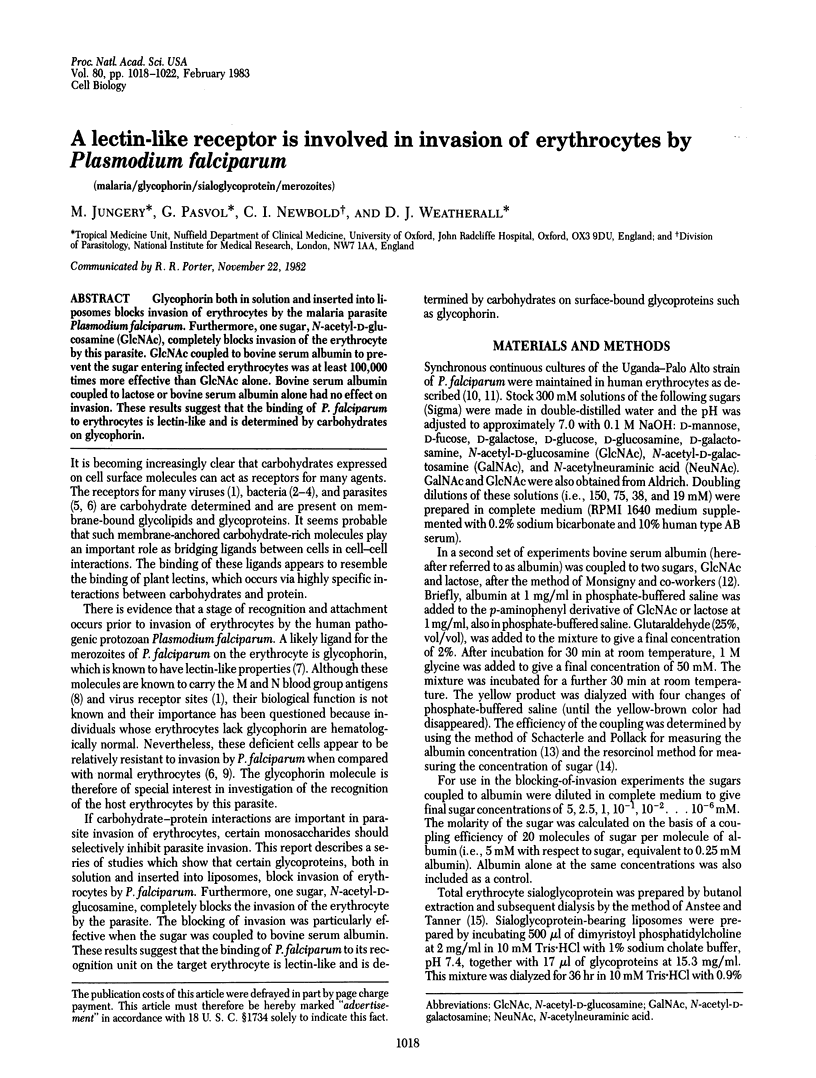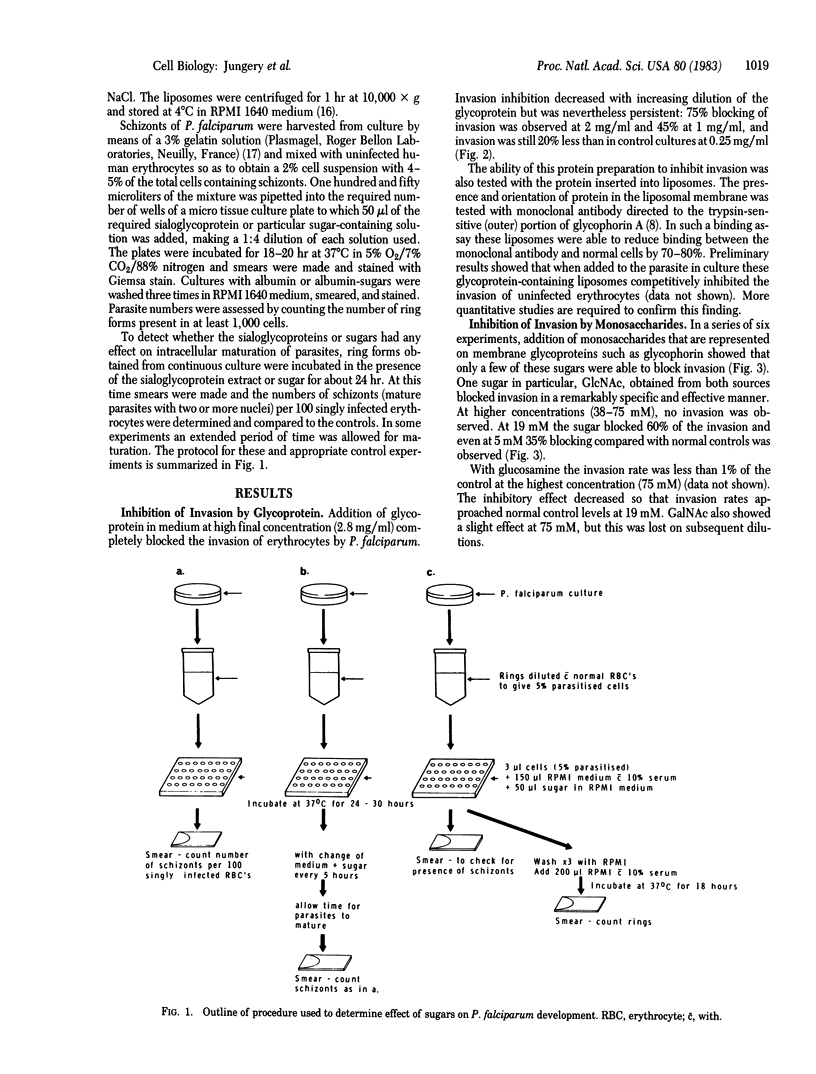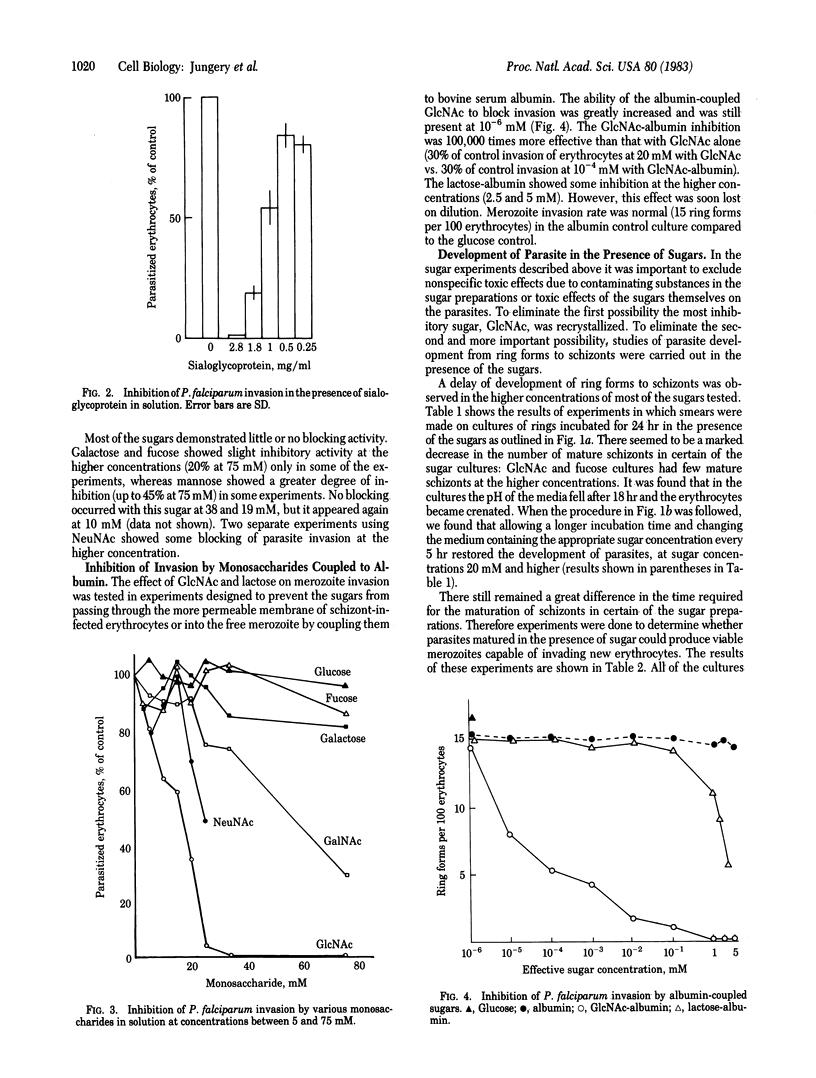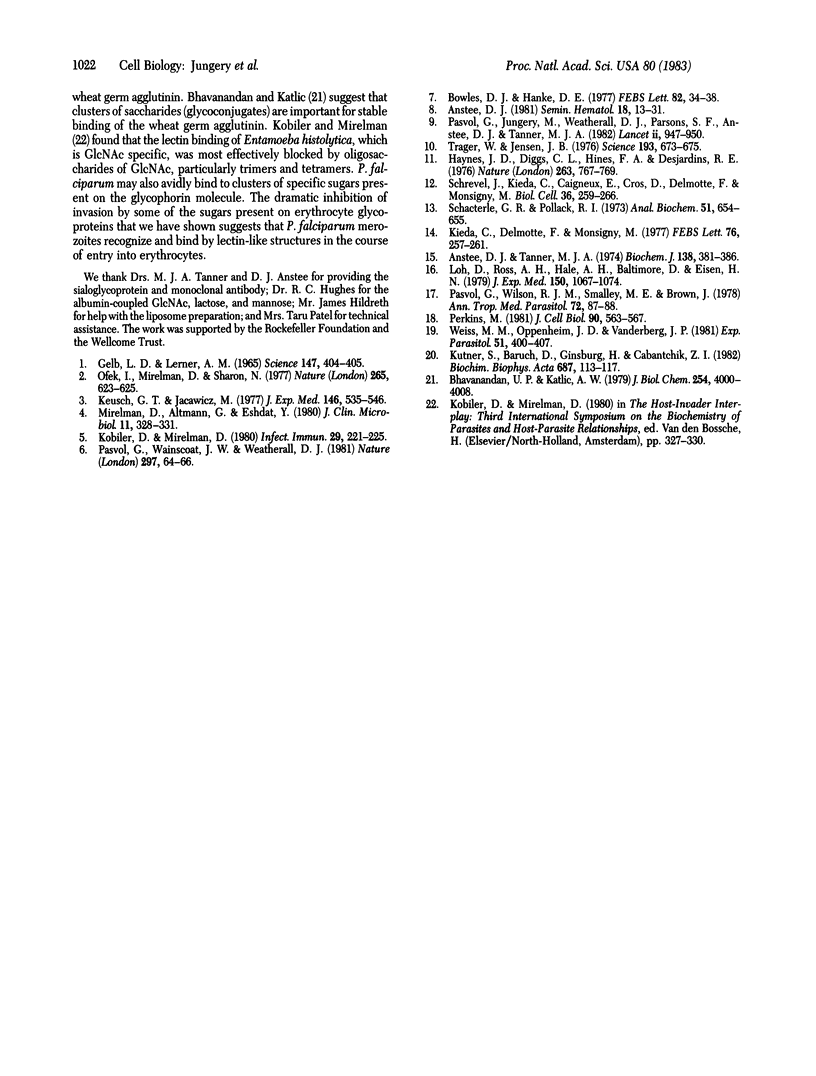Abstract
Glycophorin both in solution and inserted into liposomes blocks invasion of erythrocytes by the malaria parasite Plasmodium falciparum. Furthermore, one sugar, N-acetyl-D-glucosamine (GlcNAc), completely blocks invasion of the erythrocyte by this parasite. GlcNAc coupled to bovine serum albumin to prevent the sugar entering infected erythrocytes was at least 100,000 times more effective than GlcNAc alone. Bovine serum albumin coupled to lactose or bovine serum albumin alone had no effect on invasion. These results suggest that the binding of P. falciparum to erythrocytes is lectin-like and is determined by carbohydrates on glycophorin.
Full text
PDF




Selected References
These references are in PubMed. This may not be the complete list of references from this article.
- Anstee D. J., Tanner M. J. The distribution of blood-group antigens on butanol extraction of human erythrocyte 'ghosts'. Biochem J. 1974 Mar;138(3):381–386. doi: 10.1042/bj1380381. [DOI] [PMC free article] [PubMed] [Google Scholar]
- Anstee D. J. The blood group MNSs-active sialoglycoproteins. Semin Hematol. 1981 Jan;18(1):13–31. [PubMed] [Google Scholar]
- Bhavanandan V. P., Katlic A. W. The interaction of wheat germ agglutinin with sialoglycoproteins. The role of sialic acid. J Biol Chem. 1979 May 25;254(10):4000–4008. [PubMed] [Google Scholar]
- Bowles D. J., Hanke D. E. Evidence for lectin activity associated with glycophorin, the major glycoprotein of human erythrocyte membranes. Implications for the structure of membranes. FEBS Lett. 1977 Oct 1;82(1):34–38. doi: 10.1016/0014-5793(77)80879-x. [DOI] [PubMed] [Google Scholar]
- GELB L. D., LERNER A. M. REOVIRUS HEMAGGLUTINATION: INHIBITION BY N-ACETYL-D-GLUCOSAMINE. Science. 1965 Jan 22;147(3656):404–405. doi: 10.1126/science.147.3656.404. [DOI] [PubMed] [Google Scholar]
- Haynes J. D., Diggs C. L., Hines F. A., Desjardins R. E. Culture of human malaria parasites Plasmodium falciparum. Nature. 1976 Oct 28;263(5580):767–769. doi: 10.1038/263767a0. [DOI] [PubMed] [Google Scholar]
- Keusch G. T., Jacewicz M. Pathogenesis of Shigella diarrhea. VII. Evidence for a cell membrane toxin receptor involving beta1 leads to 4-linked N-acetyl-D-glucosamine oligomers. J Exp Med. 1977 Aug 1;146(2):535–546. doi: 10.1084/jem.146.2.535. [DOI] [PMC free article] [PubMed] [Google Scholar]
- Kieda C., Delmotte F., Monsigny M. Preparation and properties of glycosylated cytochemical markers. FEBS Lett. 1977 Apr 15;76(2):257–261. doi: 10.1016/0014-5793(77)80163-4. [DOI] [PubMed] [Google Scholar]
- Kobiler D., Mirelman D. Lectin activity in Entamoeba histolytica trophozoites. Infect Immun. 1980 Jul;29(1):221–225. doi: 10.1128/iai.29.1.221-225.1980. [DOI] [PMC free article] [PubMed] [Google Scholar]
- Kutner S., Baruch D., Ginsburg H., Cabantchik Z. I. Alterations in membrane permeability of malaria-infected human erythrocytes are related to the growth stage of the parasite. Biochim Biophys Acta. 1982 Apr 23;687(1):113–117. doi: 10.1016/0005-2736(82)90178-x. [DOI] [PubMed] [Google Scholar]
- Loh D., Ross A. H., Hale A. H., Baltimore D., Eisen H. N. Synthetic phospholipid vesicles containing a purified viral antigen and cell membrane proteins stimulate the development of cytotoxic T lymphocytes. J Exp Med. 1979 Nov 1;150(5):1067–1074. doi: 10.1084/jem.150.5.1067. [DOI] [PMC free article] [PubMed] [Google Scholar]
- Mirelman D., Altmann G., Eshdat Y. Screening of bacterial isolates for mannose-specific lectin activity by agglutination of yeasts. J Clin Microbiol. 1980 Apr;11(4):328–331. doi: 10.1128/jcm.11.4.328-331.1980. [DOI] [PMC free article] [PubMed] [Google Scholar]
- Ofek I., Mirelman D., Sharon N. Adherence of Escherichia coli to human mucosal cells mediated by mannose receptors. Nature. 1977 Feb 17;265(5595):623–625. doi: 10.1038/265623a0. [DOI] [PubMed] [Google Scholar]
- Pasvol G., Jungery M., Weatherall D. J., Parsons S. F., Anstee D. J., Tanner M. J. Glycophorin as a possible receptor for Plasmodium falciparum. Lancet. 1982 Oct 30;2(8305):947–950. doi: 10.1016/s0140-6736(82)90157-x. [DOI] [PubMed] [Google Scholar]
- Pasvol G., Wainscoat J. S., Weatherall D. J. Erythrocytes deficiency in glycophorin resist invasion by the malarial parasite Plasmodium falciparum. Nature. 1982 May 6;297(5861):64–66. doi: 10.1038/297064a0. [DOI] [PubMed] [Google Scholar]
- Pasvol G., Wilson R. J., Smalley M. E., Brown J. Separation of viable schizont-infected red cells of Plasmodium falciparum from human blood. Ann Trop Med Parasitol. 1978 Feb;72(1):87–88. doi: 10.1080/00034983.1978.11719283. [DOI] [PubMed] [Google Scholar]
- Perkins M. Inhibitory effects of erythrocyte membrane proteins on the in vitro invasion of the human malarial parasite (Plasmodium falciparum) into its host cell. J Cell Biol. 1981 Sep;90(3):563–567. doi: 10.1083/jcb.90.3.563. [DOI] [PMC free article] [PubMed] [Google Scholar]
- Schacterle G. R., Pollack R. L. A simplified method for the quantitative assay of small amounts of protein in biologic material. Anal Biochem. 1973 Feb;51(2):654–655. doi: 10.1016/0003-2697(73)90523-x. [DOI] [PubMed] [Google Scholar]
- Trager W., Jensen J. B. Human malaria parasites in continuous culture. Science. 1976 Aug 20;193(4254):673–675. doi: 10.1126/science.781840. [DOI] [PubMed] [Google Scholar]
- Weiss M. M., Oppenheim J. D., Vanderberg J. P. Plasmodium falciparum: assay in vitro for inhibitors of merozoite penetration of erythrocytes. Exp Parasitol. 1981 Jun;51(3):400–407. doi: 10.1016/0014-4894(81)90127-2. [DOI] [PubMed] [Google Scholar]


